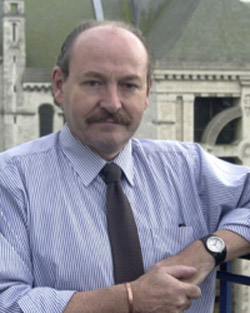Orchard Gallery
Derry City Council was responsible for setting up the Orchard Gallery on Orchard Street in the city of Derry, McGonagle was appointed to the post of curator in 1978 and remained there until 1984 during the height of The Troubles. He gave up painting a year after he joined the Orchard. [1] Orchard Gallery established itself on a minimal budget, and McGonagle found that international artists were attracted by the concept of addressing the issues of communities in conflict. [2]
In 1983, he worked briefly for the Institute of Contemporary Arts in London, while keeping close contact and transferring exhibitions to the Orchard. He returned to Orchard in 1986 to continue running the gallery for another four years. [3] In 1987 he became the first ever arts administrator to be shortlisted for the Turner prize for his work at the Derry gallery. [4]
Irish Museum of Modern Art
In 1990, McGonagle was appointed director of the newly established Irish Museum of Modern Art (Imma) in Dublin. [5]
He supported the contentious decision to use the 17th century Kilmainham Hospital location, as opposed to a new purpose-built premises in the then redeveloping Dublin Docklands area. [6] Aidan Dunne of the Irish Times notes that at Imma "over the years... the lack of a large exhibition space has on occasion been a drawback." [7] Hugh Linehan, arts and culture editor at The Irish Times, commented in 2021 that McGonagle "...fatefully insisted it should be located in the Royal Hospital", and that "Imma has struggled to define itself against the backdrop of a beautiful but not very well-suited exhibition space." [8]
McGonagle developed a strategy for working with contemporary artists to collect "for the future", he proposed to give educational and community-related programmes equal importance to the curatorial work. [2] The inaugural exhibition included works of Picasso, Mondrian, Gris, Braque, Giacometti and Miró. [9]
In relation to Imma's collection, McGonagle is quoted as saying "most of what we buy is Irish," in 1993, "but I'm not operating a quota system. Part of that has to do with the practical dimension of how often you see international work. £100,000 is actually quite a modest sum, although it's a lot in Irish terms, so it's only right that we redistribute that wealth back into the system [...] " [10] In 1994 the gallery acquired a semi-permanent Lawrence Weiner work for £20,000. [11]
During his ten-year appointment as director at the Irish Museum of Modern Art, McGonagle saw the conversion of the property's stables into accommodation and studio spaces, the (then) part-derelict Deputy Master's House restored as a specialist exhibition space, and the 48 acres of the grounds dotted with contemporary sculptures. [10] [1]
In 1996, Irish abstract artist Gerald Davis wrote an article in The Irish Times , criticising McGonagle's vision for Imma and calling for more historical and contemporary Irish artists to be represented at the gallery. He noted that "the Irish Museum of Modern [sic] largely ignores the contribution made by our own artists of the last 50 years and does not regularly make a cross-section of their work accessible to the public. The current policy of promoting that which is internationally fashionable is, in essence, provincial." [12]
The gallery's highest footfall to date was recorded in 1997 at 350,000, as a result of the popular Andy Warhol exhibition. [13] In 1999, Imma administered the first Nissan Millenium Art Project award of £40,000 for a temporary artwork. The award was granted to Dorothy Cross for her 'Ghost Ship' project. [14]
CityArts
City Arts Centre, a community arts organisation founded in 1973, did not receiving Arts Council funding in 2001. [15] [16] McGonagle was then hired as director and under his leadership the Centre began a process of cessation, starting with the closure of the Centre for 2 years with all staff made redundant and all activities stopped. City Councilor Mannix Flynn, on the closure of the City Arts Centre, said that “Dublin lost an arts community down there, the community lost an arts centre, lost employment”. [17] McGonagle launched a 'Civil Arts Inquiry' (a two year series of "conferences and recorded public debates") meanwhile earning €50,000 per year. [16] [18] [19] The 'Inquiry' had skeptics, dismissing it for not engaging with the art community and as a profit-driven waste of time, without producing any results. [20] [16] Under McGonagle the Centre's building and property on Moss Street in central Dublin was sold in 2003 for more than €4.2 million, making it the richest arts organisation in Ireland at the time. [16]
After the sale, the City Arts Centre spent the next few years in a basement office and in 2007 bought a smaller building on Bachelor's Walk. However, it needed repairs and only reopened in 2010 (as CityArts). At this time the organisation had spent nearly all of its savings between operational costs, archiving, the 'Civil Arts Inquiry', redundancy packages, and the new building with its renovations. [16] In 2012 CityArts voluntarily liquidated, with the new building becoming the property of the Dublin City Council. As of 2024 the old Moss Street building has remained unused and undeveloped. [17] [21] [22]

